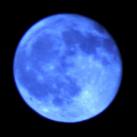Diversions May 30, 2007
Blue Moon
Tonight – depending on where you live – you’ll be treated to a “blue moon.″
Reported by Nevin E. Adams
Not that it’s as rare as one might think – depending on your definition.
Blue moons can be truly blue – caused by smoke or dust particles in the atmosphere, such as happened after forest fires in Sweden in 1950 and Canada in 1951 and, notably, after the 1883 eruption of Krakatoa, which caused blue moons for nearly two years. Those blue moons are exceedingly rare (thankfully, for those living in proximities to active volcanoes).
“Once’ Upon a Time
However, those looking forward to tonight’s blue moon are relying on the definition associated with the phrase “once in a blue moon.’ That refers to situations where there are two full moons in the same calendar month. Full moons are separated by 29 days, while most months are 30 or 31 days long – so it is clearly possible to fit two full moons in a single month (and, yes, 31-day months are more likely to have blue moons). In fact, it happens about every 32 months, on average.
Still, the traditional – and more complex definition of a blue moon – was a rarer occurrence. It was the name given to the third full moon in a season that has four full moons.
That usage, in turn, harkens back to the desire of the early Christian church to calculate the correct date of Easter, following clues in the bible. This must fall on the Sunday immediately following the 14th day of the Paschal Moon, which in turn falls on or after the day of the ecclesiastical vernal equinox, which is fixed as the 21st of March. It can never occur before the 22nd of March or after April 25. Lent, which begins 46 days before Easter, contains the Lenten Moon. Now, by tradition, all 12 full moons of a year have names, some religious like those above and the Moon Before Yule and the Moon After Yule, and some relating to seasonal activities and events such as Flower Moon, Hay Moon, Harvest Moon, and Hunter’s Moon. In fact, the main function of a Blue Moon originally was to preserve the relationships between these religious and lunar events in those years when there is a 13th full moon (1).
Then…it Gets Complicated
Then, in 1943, Sky & Telescope writer Laurence J. Lafleur answered a reader’s question by quoting from the 1937 Maine Farmers’ Almanac that “occasionally the Moon comes full 13 times in a year.” In 1946 James, Hugh Pruett, in an article in the same magazine, referred to Lafleur’s earlier item – but expanded that the 13th full moon in a year “gives 11 months with one full moon each and one with two. This second in a month, so I interpret it, was called Blue Moon.”
But what really seems to have set the new definition in stone was a January 31, 1980, broadcast of National Public Radio’s StarDate program, where Deborah Byrd quoted Pruett’s assertion; this was, in turn, picked up by the international news wire, and voila, blue moons became more common.
When Will It Be Blue?
This time around, the moon will turn full on May 31 at 9:04 p.m. Eastern Daylight Time, as it did on May 2 on these shores. But for those living in Europe, Africa, Asia, and Australia, that same May 31 full moon occurs after midnight, on the calendar date of June 1. So in those regions of world, this will not be second of two full moons in May, but the first of two full moons in June.
Or you might just want to check out another very bright object near the moon tonight – the planet Jupiter.
You can check out the blue moon calendar at http://www.obliquity.com/cgi-bin/bluemoon.cgi
(1)The last time that more complex type of blue moon occurred was August 2005 – the next will be May 2008 – and that was the definition included in the Maine Farmers’ Almanac (now called the Farmers’ Almanac Rule).
